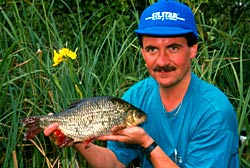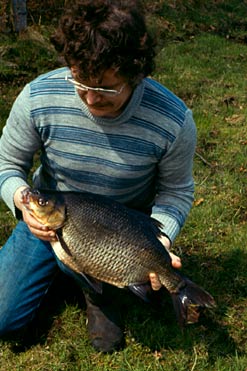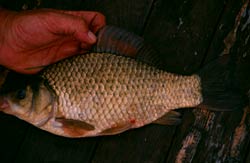I’ve fished for big roach in the Dorset Frome and Stour for thirty years, hence my interest in big roach. Over the last three years I have been collecting articles and books on big roach, accumulating a vast library.
During my much more recent researches I spoke to Mike and he provided detail on the chemical method described in my letter in Angling Times of 3/12/02. Mark’s Letter to AT THERE are three ways to determine true roach. The first is to kill them, and examine the pharyngeal teeth – not always conclusive, as Dick Walker’s crusade against Bert Brown’s equal-record fish identification proved. Alternatively, take a tissue sample from the fish and use a method called Iso Electric Focusing (IEF). The tissue is mashed up with certain chemicals and the proteins (enzymes) are extracted and spread across a plastic film, using electric currents (description courtesy of Dr Mike Ladle). Or, thirdly, you can use DNA samples. Physical characteristics, such as fin ray and scale counts, are useless for roach/rudd hybrids. The shape of the mouth is not always a giveaway, although the presence of an abdominal keel may give clues to rudd parentage. The other question to which there seems to be no definitive answer is, can roach and rudd produce fertile hybrids that could breed either with other hybrids or pure-bred parent stock, thereby giving rise to fish that are 75 per cent roach and 25 per cent rudd? Only large-scale sampling using methods one and two, as described above, might provide an answer. Mark Wintle, I also discussed F1 hybrids with him. In a nutshell it appears that one of the main reasons that hybrids are usually sterile is that the chromosome pairs do not add when a hybrid attempts to breed with a pure parent fish.
What I have been unable to find is proof that this actually holds true. If it does then two species with a gap of four chromosomes might be able to breed with true parent fish or, worse still, with an entirely different fish, ie, is it possible for a bream to breed with a roach/rudd hybrid? If a hybrid bred with another hybrid of the same type then one ought to get more hybrids that are exactly the same. If it does hold true then knowledge of the chromosome pairs ought to provide a table of what is theoretically possible. And at what point is a fish too remotely related to breed with another? Here the cyprinid fish tend to fall into separate groups: 1. roach, rudd, bream, chub, bleak, silver bream. 2. carp, crucians, goldfish. There seems to be no evidence of barbel, gudgeon, tench, minnows, dace (breed too early) ever hybridising with any of the other cyprinids. We have also now got Ide becoming more widespread. There are a number of other aspects that have not really come out in this debate. Scale, fin ray counts and photographs are unreliable The first one is that although a hybrid is genetically midway between the two parent species the secondary characteristics, ie, colour, fin ray counts, scale counts will vary considerably, so a roach/bream hybrid might be quite bronze like a bream or have some of the blue sheen like a roach, though less than the parent fish. This makes reliance on fish identification through looking at photos a very risky game particularly as most films have a colour bias/colour intensification (+40% typically). Mostly the hybrid fish will have characteristics that fall about midway – but not always. I have unearthed the following quote from Dick Walker: “A true roach can easily be distinguished from either hybrid (roach/rudd, roach/bream) by counting the number of rays in its anal fin. If the fin has more than 12 branched rays the fish is not a true roach. Actually an experienced angler can spot a roach/bream hybrid at a glance. The other hybrid, the roach/rudd, is more difficult to distinguish. …..McMahon says the roach/rudd hybrid will have 42 or 43 scales in the lateral line; true roach have 40 to 46 and rudd 39 to 44, so that this test tells us little, except that a fish having 44 to 46 lateral line scales, and which looks like a roach, is a roach and not a roach/rudd hybrid; a fish of similar appearance with 42 or 43 lateral line scales could be either. McMahon further says that in a roach/rudd hybrid ‘the beginning of the dorsal fin is in a direct line above the middle of the ventral fins or over the tip of the little loose scale bordering these fins’. If the presence of 42 or 43 lateral line scales and the position of the dorsal fin lead one to suspect the fish is a hybrid send a scale to someone who knows how to read them as the absence or otherwise of spawning marks will show whether the fish is a hybrid, while other indications will also help determine its identity.” Walker obviously did not believe that roach/rudd hybrids could breed. Local characteristics Local races of pure bred fish, eg, roach, do occur and gain local characteristics; body shape, colouration, fin ray counts, etc. Where I live in Dorset some roach show a bluish tinge along the rear of the tail that is only found in some waters. Compare a typical Stour roach with a Fen fish and you would see what I mean. Against this is the phenomenal amount of restocking that has occurred over the years, so the pedigree of fish is completely mixed up in many waters For instance, it was common practice to take Nadder/upper Hants Avon fish to restock the Stour in the fifties and sixties, never mind the Danish fish in the seventies. This leads to the appearance of even true bred fish having considerable variance. Hybrids grow bigger There is little doubt that hybrids of roach/rudd grow bigger than true roach or rudd and yet they do develop spawn. What gives them this added vigour? What hybrids are possible? I have caught roach/bream, roach/rudd, rudd/bream, bleak/chub (Thames), silver bream/roach (Kennet &Avon canal) and chub/roach (Thames). What method is best for determining hybrids? DNA that only requires a small sample, such as an authenticated scale from the fish, is by far the favourite. The other method that involves taking a tissue sample from the fish and using a method called Iso Electric Focussing (IEF) or Poly-Acrylamide Gel Electrophoresis (PAGE) that I mentioned in my letter to AT needs more than a scale (so I understand). There are very few labs able to undertake this test. The drawback that you may find against DNA is cost. I have heard mention that it might cost as much as £ 1000 per sample.
Crucian carp Originally crucians formed a few local populations of usually stunted fish. Goldfish were usually the colourful type and also small. Once the demand for stock fish accelerated in recent years large quantities of brown goldfish, rejected by fish breeders, began to be more widely stocked and the problems began. There are physical differences between crucians and goldfish. Scale counts and gill arch counts have hardly any overlap. Fantails and silverish colouration also indicate goldfish ancestry. What complicates matters a great deal is the existence of hybrids – crucian/common carp are rare but do exist. The shape of the fish is between that of a carp and a crucian with two tiny barbules. Because these fully scaled fish can reach a weight of 5-7lbs (my best is 5lbs) care is needed so that a ‘record’ is not accepted. Given the possibility of similar hybrids for brown goldfish and crucian/brown goldfish hybrids more research is definitely required using DNA. I have also uncovered mention of a fast growing German race of crucians called ‘Spechthausen’. There is a possibility that, like carp, the original English races of crucians were small fish and that much better developed fish have been introduced to this country in the recent past. It is not beyond the realms of fantasy that someone like Leney brought fish in from the Continent. He did, after all, bring in black bass and Galician strains of carp from France and Germany. Silver bream What about silver bream – hard to take seriously unless you’re trying to win a match. No-one is even sure how big they grow – my guess is about 2lbs. Certainly the record is far too low. Silver bream are not difficult to identify with the practiced eye; the compressed, deep body and very large eye show how they are closely related to bleak. Add a dark grey tinge to the anal fin and touch of pink in the other fins. They are mostly confused with roach/bream hybrids especially when small, hence the common reports of nets of ‘hybrids’ on the Trent. These fish are much more common than usually supposed, even found in the Dorset Stour below Throop weir. It is interesting that two of our best known match anglers, Kim Milsom and Tom Pickering, actually mention catching silvers in articles and know enough about them to know their habits. In the past, smallish bronze bream of 2-3lbs that had not yet got that bronze look even ended up in glass cases but a quick scale count discounts them. There are silver bream hybrids, mainly with roach, in theory with bream and rudd. One finds the body is less compressed and not so deep in these hybrids. This is very much the limit as far as hybrid research needs to go. Good photos ought to be enough to identify a silver bream provided there is enough detail on scale/count, eye, and anal fin ray count. A lighter note On a much lighter note I am constantly amused by references to ‘hybrids’, especially on the tidal Trent and the Bristol Avon when in most case these are simply silver bream – no wonder the record is so low! Match fishing years ago on the Bristol Avon I challenged locals that the fish in my net were silver bream not hybrids. Against a wager a sample fish was taken to EA labs in Bristol for checking – my identification was proved correct. I never did collect the wager. Tight Lines Mark Wintle Join in the debate on the forum |
Welcome!Log into your account













